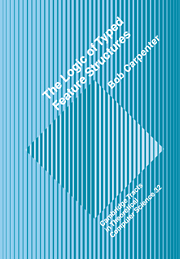 The Logic of Typed Feature Structures
The Logic of Typed Feature Structures Published online by Cambridge University Press: 12 October 2009
Up to now, our presentation of feature structures has been fairly standard. In particular, our feature structures are identical to the finite sorted feature structures introduced by Pollard and Moshier (1990) and axiomatized by Pollard (in press). In terms of the informational ordering that they produce, our feature structures (modulo alphabetic variance) are nothing more than a notational variant of the ψ-terms of Aït-Kaci (1984, 1986) (modulo tag renaming and top “smashing,” with a bounded complete partial order of types). The important thing to note about the feature structures is that although we allowed a combination of primitive information with type symbols and structured information in terms of features and their values, there was no notion of typing; arbitrary labelings of directed graphs with type symbols and features were permissible.
In this chapter we introduce our notion of typing for feature structures, which is based on the notion of typing introduced informally by Pollard and Sag (1987:38) for the HPSG grammar formalism. Pollard and Sag introduced appropriateness conditions to model the distinction between features which are not appropriate for a given type and those whose values are simply unknown. Note that since appropriateness is defined as a relation between types and features, we say both that types are appropriate for features or that features are appropriate for types. We have already seen how the type symbols themselves are organized into a multiple inheritance hierarchy and how information from the types interacts with information encoded structurally in terms of features and values.
To save this book to your Kindle, first ensure [email protected] is added to your Approved Personal Document E-mail List under your Personal Document Settings on the Manage Your Content and Devices page of your Amazon account. Then enter the ‘name’ part of your Kindle email address below. Find out more about saving to your Kindle.
Note you can select to save to either the @free.kindle.com or @kindle.com variations. ‘@free.kindle.com’ emails are free but can only be saved to your device when it is connected to wi-fi. ‘@kindle.com’ emails can be delivered even when you are not connected to wi-fi, but note that service fees apply.
Find out more about the Kindle Personal Document Service.
To save content items to your account, please confirm that you agree to abide by our usage policies. If this is the first time you use this feature, you will be asked to authorise Cambridge Core to connect with your account. Find out more about saving content to Dropbox.
To save content items to your account, please confirm that you agree to abide by our usage policies. If this is the first time you use this feature, you will be asked to authorise Cambridge Core to connect with your account. Find out more about saving content to Google Drive.